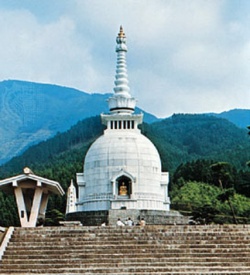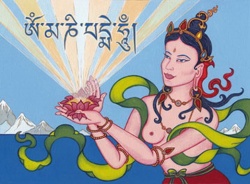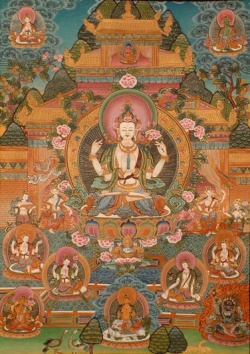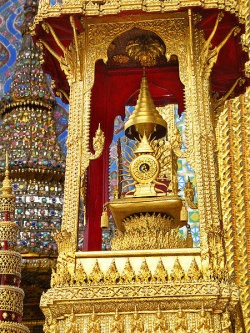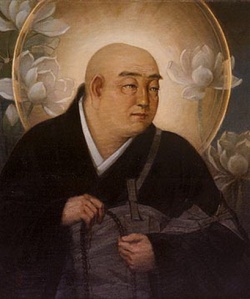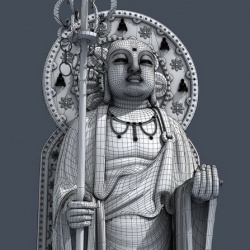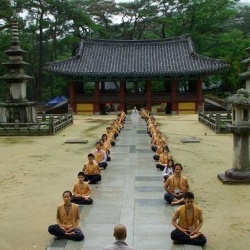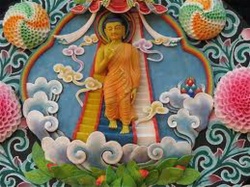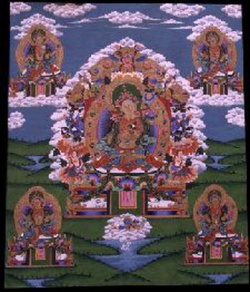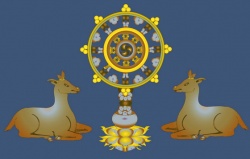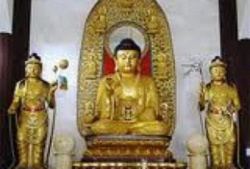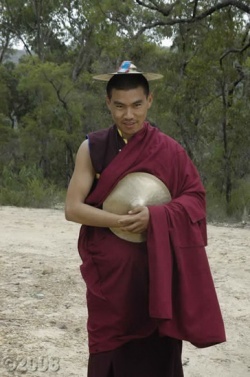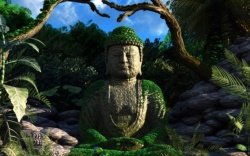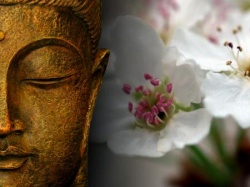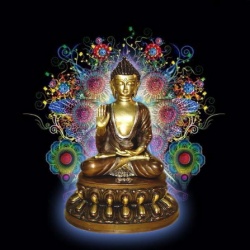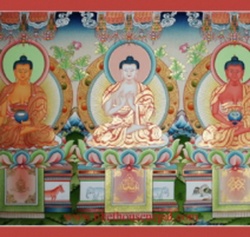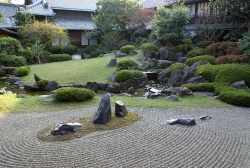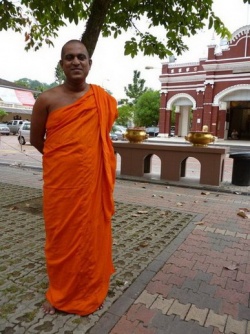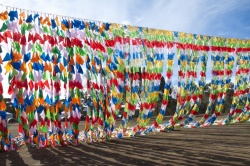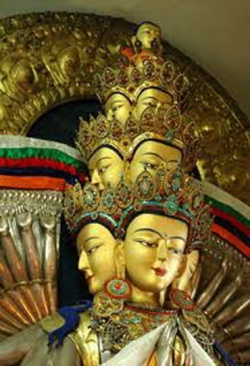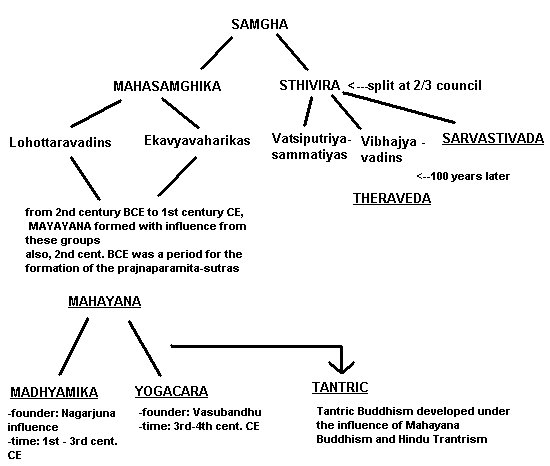Buddhism: Chronology and History
Buddhism in India
Before 2200 BCE:
- Indus Valley Civilization
- refers to people living in the Indus River Valley in India in the third millenium BCE (c. 2500 BCE)
- significant evidence for the worship of goddesses in conjunction with bull or ram figures
- Harappa and Mohenjo-Daro were the principle cities of the region, c. 2500-1250 BCE
- the region was well-organized with evidence of well-developed societies, scholarship, etc.
2200-1500 BCE:
-Indus Valley civilization disappears (due to possible invasion by Aryans arriving c.1500 BCE?)
-Religious oral traditions and hymns began to be collected
1000-500 BCE:
-The Vedas and the religious diversity of Hinduism is rooted in the Indus Valley civilization
-Collection of Expositions, which include Brahmanas and Upanisads, which are also included in the scriptures of Hinduism
-The upanisads are a written composite and philosophical exploration on works orally composed.
-They intend to present the meaning of religious practice and thought up against or in response to the Vedas.
-a few centuries before the life of Buddha, a tradition of Wanderers wanted liberation, and were the early roots of Buddhism.
-Two kinds of Wanderers:
563-483 BCE:
Life of The Buddha, or Siddhartha Gautama, "The Buddha"
- Buddha is the great teacher from the Buddhist tradition
- his teachings are based in the Vedic tradition
- referred to as the "enlightened one" or "one who has awakened"
Brief chronology of Siddhartha's life:
- born into the ksatriya varna as son and heir of a local ruler
- accidentally attained a meditational experience in youth
- sneaks out of the palace and finds and old man, a sick man, a corpse, and an ascetic; IE: the Four Passing Sights
- wants to overcome the sickness, suffering, and death in the world that he witnessed in those 4 people
- age 29, Siddhartha renounces the world and begins the path to enlightenment
- when enlightened, Siddhartha, now "The Buddha," experiences the cornerstone of the 4 Noble Truths and the 4 dhyanas
- Buddha dies around 483 BCE
- Note: Siddhartha's birth and death dates are controversial. It is widely held in Sri Lanka and Southeast Asia that Siddhartha's life spanned from 624-544 BCE, and in Europe, America, and India from c.566-486 BCE, and further in Japan from 448-368 BCE.
500-250 BCE
-period of the 4 Councils of Buddhism
- First Council (after Buddha's death c. 483 BCE)
--location: Rajagrha
--500 monks gathered to compile Siddhartha's teachings (into a sort of canon), establishing a direction for Buddhism after Siddhartha's death
- Second Council (c.383 or 373 BCE)
--location: Vaisali
--questioning of the 10 points
--possible time of the Great Schism according to some sources
- "Second" Second Council, or 2/3 Council (around 346 BCE)
--location: Pataliputra
--first true Great Schism of Buddhism, where the Samgha, or Buddhist order/group split into two separate schools, called Mahasamghikas and Sthaviras
- Third Council (c.250 BCE)
--location: Pataliputra
--schism again occurs to separate a third school called sarastivadins
--Asoka(c. 270-230 BCE) was overseer
269-232 BCE
-Asoka is the third monarch of the Mauryan Dynasty in India
- c.258, Asoka leads a bloody military campaign in the village/region of Kalinga
- the witness of such carnage inspired his conversion to Buddhism
- as a king, he brought India together
- referred to as the pious ruler, establishing a sense of social justice in the region (ie. social service, medical care, humane treatment of the masses)
- became a lay disciple
- ruled over the third council
- sent out missionary efforts to spread Buddhism to other places, i.g: Indian sub-continent, Burma, Sri Lanka, etc.
- Dharma-conquest -- reigned with good moral principles
Nagarjuna (c.150-250 CE):
-associated with the Madhyamika school of Mahayana Buddhism
-advocate of the Middle Way between asceticism and hedonism in Buddhist practice
-remembered for his teachings on emptiness or sunyata
-confusion about the biography of Nagarjuna persists, as texts are attributed to him over a five hundred year period
-his principle work is Mulamadhyamikakariakas, in which he critically examines other schools of Buddhism of his time period
Asanga (c.315-390 CE):
-founder of the yogacara school of Mahayana Buddhism
-emphasized the practice of Yoga or meditation (hence, Yogacara)
-the elder brother of the prominent Buddhist philosopher, Vasubandhu
-known for his treatise on The Seventeen Stages of yoga, as instructed by bodhisattva Maitreya
-also, Asanga's Abhidharmasamuccaya attempts to exlicate the elements of phenomenal existence from the perspective of the Yogacara school
Vasubandhu (forth or fifth century CE):
-converted from Abhidharma Buddhism to Mahayana
-followed his brother Asanga in converting from Abhidhgarma Buddhism to Mahayan Buddhism, in particular, the Yogacara school (eventually the Vijnanavada school for Vasubandhu)
-he is connected historically to three distinct persons, and thus his biography is not clear
-later in life he moves from a concentration on Yoga practice to Buddhist theory
-he was the author of Abhidharmakosa, an encyclopedic work on Buddhist doctrines and philosophy
-Author of Vimsatika (20 verses) and Trimsika (30 verses)
Dignaga (c.480-540 CE:)
-the ascribed founder of Buddhist logic
-early on, affiliated with the vatsiputriya school of Abhidhgarma Buddhism, later the Nayaya school
-studied under the great buddhist philosopher Vasubandhu (Vijnana-vada phiosophy)
-thought to have written more than a hundred treatises on logic
-was the first Buddhist thinker to consider seriously the "validity or invalidity" of knowledge
Paramartha (c.498-569 CE):
-a notable biographer, missionary and translater of the Buddhist tradition
-studied at the famous Universtity of Nalanda
-spent a considerable amount of time "on mission" in china
-while in China he sitinguished himself as a translator of Sanskrit scriptures into chinese (translating the equivalent of 275 volumes in Chinese)
-he was largely responsible for the introduction of Vasubandhu's philosophy to China
Dharmapala (c.530-561 CE):
-associated with the yogacara school of Mahayana Buddhism
-his most influential work is the Parmattha-dipani
-principally responded to the work of an earlier thinker, that of Buddhagosha
-studied at the famous University of Nalanda, later becoming its abbot
-made significant contributions to the Buddhist discussion of "self" and consciousness from a Yogacara school perspective
-a Chinese pilgrim-monk who travelled to India in search of the roots of the Mahayana buddhist tradition (late Sui and early T'ang dynasties)
-great Buddhist scholar and advisor to the emperor of China
-studied extensively both the Abhidhgarma and Mahayana Buddhist traditions, as well as the contemporary, standard Vedic curriculum
-he contributed significanly to the Chinese Buddhist canon as a translator of Indian texts into chinese (this was well funded bye the Chinese government, as he had excellent connections)
-his work in its more pure form lives on in the Hosso school of Japanese Buddhism
Dharmakirti (c.600-660 CE):
-in early life Dharmakirti studied extensively the scholarship of the Vedas and other buddhist phiosophy
-he eventually pursued the study of logic, following in the footsteps of his predecessor, Dignaga
-was the student of a direct pupil's of Dignaga
-widely considered a genius of his time, Dharmakirti's theory of knowledge forced numerous revisions within the works of other thinkers and other traditions
-significantly, he challenged the divine infallibility of the Vedas
Buddhism Outside India: Southeast Asia
Ceylon (Sri Lanka)
247 BCE
-One possible view of Buddhism in spread into Ceylon
-Asoka, emperor of India, sends Mahinda to Ceylon on a missionary trip, who introduces Buddhism to Ceylon
250-210 BCE:
-Second possible view of Buddhism is spread into Ceylon
-Devanampiyatissa leads the conversion of the island
3rd Century CE:
-A sect of Vaitulyavada makes an enterance into Ceylon
4th Century CE:
Vietnam
111 BCE:
-Meu-Po, a Buddhist fugitive from China, propogates Mahayana Sutras in Vietnam
2nd Century CE:
-A-Ham, one of the 2 major Vietnamese sects of Buddhism, begins to take shape
3rd Century CE:
-Mahayana and Abhidhgarma missionaries travel through Vietnam
580 CE:
-Vinitaruci spreads second major Vietnamese Buddhist school, called Thien
820 CE:
-Vo-ngon-Thong continues to develop the Thien school of Buddhism
968-980 CE:
-Dinh Bo-Linh spreads a form of Buddhism known as Amidism
Korea
1st Century CE:
-Korea's early development is intimately tied to its relations with China (keeping in mind that the process of development is interactive)
-Earliest form of religion in Korea is called Shamanism
-Chinese colonies spring up in Korea
-Buddhism is transmitted to Korea during the Three Kingdoms Period (c.370-670CE)
372-384 CE:
-Monk Shun-tao from china introduces Buddhism to Korea
-Monk Malanada spreads Buddhism farther in 384 CE
-the first Buddhist monastery erected on Korean soil (c.376)
-broad regional reception and acceptance of Buddhism under the Seradian monk Maranani'a (c.384-onward)
528 CE:
-Monk Ichadon was martyred, and therefore this is the "official" date of introduction
-the last of the Three Kingdoms, that of Silla, embraces Buddhism
6th and 7th Centuries CE:
-in conquering the other two kingdoms, that of Koguryo and Paekehe, Silla found it politically advantageous to support the spread of Buddhism
-Korean monks are sent to China to bring back Buddhist teachings
-the scholastic schools of Chinese Buddhism were introduced into Korea
-ideologies were consolidated and new schools were organized
-Pomnany brings Ch'an (in Korean: "Son") school of Budddhism, taught by Tao-hsin, the fourth patriarch of the Chinese Ch'an school, back to Korea
935-1392 CE:
-called Koryo Period
-Buddhism reaches its peak importance at this time in Korea
-the Koryo School of Buddhism inspires a reconciliation between the Son and scholastic schools
-the unification of these two schools would occupy numerous religious figures over the next centuries
14th and 15th Centuries CE:
-Yi dynasty in power (c.1392)
-Kings were hostile toward Buddhists
Buddhism In China
Table of Chinese Dynasties
| Shang | 1766-1125 BCE |
| Chou | 1122-256 BCE |
| Ch'in | 221-206 BCE |
| Han | 206 BCE -220 CE |
| The Three Kingdoms | |
| Wu | 222-280 CE |
| Wei | 220-265 CE |
| Shu | 221-263 CE |
| _ | |
| Western Chin | 265-316 CE |
| Eastern Chin | 317-420 CE |
| Liu Sung | 420-479 CE |
| Ch'i | 479-502 CE |
| Liang | 502-557 CE |
| Ch'en | 557-589 CE |
| Sui | 581-618 CE |
| T'ang | 618-907 CE |
| Wu-Tai | 907-960 CE |
| Sung North | 960-1127 CE |
| Sung South | 1127-1279 CE |
| Yuan | 1280-1368 CE |
| Ming | 1368-1644 CE |
| Ch'ing | 1644-1912 CE |
Centuries Before 1st Century BCE:
-Taoism and Confucianism are existing religions in China
1st Century BCE - 1st Century CE:
-Buddhism begins to enter China along trade routes
-Buddhism was often mistaken for a simple form of Taoism
-Mahayana was preferred over Abhidhgarma
61-64 CE:
-Emperor Ming sends embassy to import Buddhism into China
2nd Century CE:
-Emperor Huan mentioned to worship Buddha
-Monks arrived in China to produce texts and translations
200-400 CE:
-Buddhism officially introduced at 219 CE
-Buddhism adapts to China, and to taoist religion, from 220-419 CE
-Sun-Lun school in China-founded by Kumarujiva (343-413) - was a master of translation, translating many influential Mahayana texts into Chinese
420-588 CE:
-Buddhism divides into sects.
-the death of Bodhidharma, first Chinese Ch'an patriarch (c.527 CE)
589-617CE:
-Hsuan-i, or hidden significance commentaries are written revelaing the characteristics of each sect
-known as the period of consolidation of Buddhism in China
618-906 CE:
-In 845, Taoist Emperor Wu-tsung sends Buddhism into a decline
-The scholastic sects of Buddhism disappeared during this time-"official" representation of Buddhism
-After the death of Wu-tsung, the popular sects of Buddhism were revived
-A new school called chen-yen was started as well
907-Present
-printing of the Buddhist canon begins (c.972 CE)
-the popular schools of Chinese Buddhism continued on through this period
-a Buddhist revival occured from 1890-1947, led by T'ai-hsu
-in 1949, Buddhism was suppressed by Communist leaders
-Both Honen and Shinran were Japanese
| Chu-she | -founded by Paramartha in 6th century CE -organized by Hsuan-tsang from 596-664 CE |
| Fa-hsiang | -founded by Paramartha -organized by Hsuan-tsang and K'uei-chi from 632-682 CE |
| San-lun | -founded by Kumarajiva, who lived from 344-413 CE -organized by Tao-sheng from 360-434 CE |
| Chen-yen | -founded by subhakarsimba -corresponds to Indian word 'mantra', which means 'true word' |
| A-pi-to-mo | -founded during the Liang Dynasty |
| She-lun | -founded during the Liang Dynasty |
| San-Lun | -founded between 344-413 CE |
| Lu | -founded during the T'ang Dynasty |
| A-pi-ta-mo | -founded in 645 |
| Ch'eng-shih T'ien-t'ai | -founder: Hui-ssu (515-576 CE) -no corresponding Indian school |
| Hua-yen | -founder: Tu-shun (557-640 CE) -organizer: Fa-tsang (643-712 CE) |
| Ch'an | -founder: Bodhidharma (470-520 CE?) -Bodhidharma: first Chinese patriarch |
| Lin-chi | -founded by Lin-chi I-hsuan (867 CE) -taken to Japan by Eisai (1141-1215 CE) |
| Ts'ao-tung | -founded by Tung-shan Liang-Chich (807-869 CE) and Ts'ao-shan Pan-chi (840-901 CE) -taken to Japan by Dogen (1200-1253 CE) |
| Ching-t'u | -founder: Hui-yuan (334-416 CE) -organizer: T'an-luan (476-542 CE)
|
Buddism In Japan
Chronology of Japanese Historical Periods:
| Jomon, Yayoi, and Kofun | (prehistoric and protohistoric up to 6th century CE) |
| Taika | 645-710 |
| Nara | 710-784 |
| Heian | 794-1185 |
| Kamakura | 1185-1333 |
| Muromachi | 1333-1568 |
| Momoyama | 1568-1600 |
| Tokugawa | 1600-1867 |
| Meiji | 1868-1911 |
| Taisho | 1912-1925 |
| Showa | 1926-1945 |
| Postwar | 1945-Present |
538 CE:
-official introduction date of Buddhism into Japan
-Korean religious figures visit Japan during the 6th century with envoys spreading Buddhism in order to obtain peace with Japan
-distinguishable beginning for Buddhism in Japan (c.552 CE)
-prince regent Shotoku (died 621) helped with the early development of Japanese Buddhism by writing commentaries of scriptures
-Buddhism is declared the state religion of Japan (c.594 CE)
710-794 CE:
-known as Nara Period
-a new phase in the development of Japanese Buddhism
-Nara Buddhism: a combination of 6 academic schools from China, sprung up during this period
-6 schools of Nara Buddhism:
- Kusha (Abhidharmakosa sect)
- Joitsu
- Ritsu (based on vinaya)
- Sanron (Madhyamika, San-lun)
- Hosso (Yogacara, Fa-hsiang)
- Kegon (Hua-Yen)
-Emperor Shomu, Empress Shotoku, and Hosso monk Gyogi, aided in the growth of Buddhism at this time
-the Taiho reforms of 702 CE caused some resistance to Buddhism
794 CE:
-beginning of the Heian Period in Japan
-capital of Japan is changed to Kyoto (794)
-ruler at time is Emperor Kammu
-the "high water mark" of Japanese Buddhism
-2 schools came from China: --1. Tendai (T'ien-T'ai) -- brought by Saicho (767-822 CE)
--2. Shingon (Chen-yen) -- brought by Kukai (774-835 CE)
-esoteric Buddhism (mikkyo)
-these 2 schools did clash along with the success they both found in this time period
1192 CE:
-beginning of Kamakura Period
-power held by a group of Samurai
-new schools of Buddhism begin that are strictly Japanese:
| NAME: | FOUNDER: | NOTES: |
| Pure Land (Jodo) | Honen (1133-1212 CE) | _ |
| True Pure Land (Jodo Shinshu) | Shinran (1173-1263) | Shinran was a disciple of Honen |
| Nichiren | Nichiren (1222-1282 CE) | Sokagakki school founded after 1945 defeat of Japan by Tsunesaburo Makiguchi as Nichiren spinoff |
| Rinzai Zen (Lin-ch'i) | Eisai | _ |
| Soto Zen (Ts'ao-tung) | Dogen (1200-1253 CE) | _ |
Buddhism In Tibet
Origins of Tibetan Buddhism
-two origins: --1. Indian Buddhism coming from Gupta Dynasty
--2. Native religions of Tibet
-Indian Buddhism was spread to Tibet in 2 ways:
--1. scholars (Santarakshita) of monastic universities bringing it back
--2. wandering Tantric saints introducing it (Padma Sambhava)
----Tantric Buddhism was also influenced by Tantric Hinduism -most of Buddhist transmission occurred during the 8th century CE
-Buddhism declared the state religion of Tibet (791 CE)
-4 main sects, which are lineages of transmission from masters to diciples exist in Tibetan Buddhism
-two major sects include:
--1. rNying-ma - introduced in the 7th and 8th centuries CE
--2. dGe-lugs - introduced by Tsung-kha-pa (1357-1419 CE)
-based upon Bon, Mahayana, and Tantra
-bases itself on the "four baskets":
- vinaya
- surtras
- abhidharma
- getri
-four nine vehicles of Buddhism:
- Hinayana
- Mahayana
- Vajryana
- Mantrayana
- 5 books of Yogacara
Lineage Of The Dalai Lama
| Gedun Truppa | 1391-1475 CE |
| Gedun Gyatso | 1475-1542 |
| Sonam Gyatso | 1543-1588 |
| Yonten Gyatso | 1589-1617 |
| Ngawang Lobsang Gyatso | 1617-1682 |
| Tsangyang Gyatso | 1683-1706 |
| Kesang Gyatso | 1708-1757 |
| Jampel Gyatso | 1758-1804 |
| Luntok Gyatso | 1806-1815 |
| Tsultrim Gyatso | 1816-1837 |
| Khendrup Gyatso | 1838-1856 |
| Trinley Gyatso | 1856-1875 |
| Thupten Gyatso | 1876-1933 |
| Tenzin Gyatso | 1935-Present |

